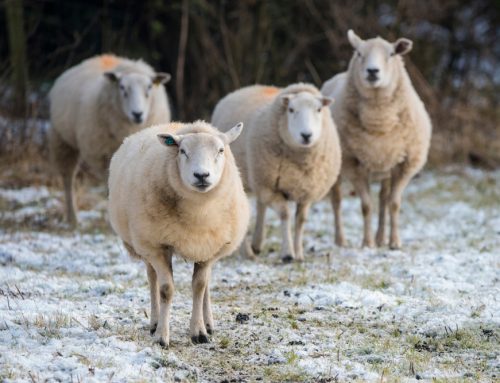In the 7th grade my son did his science project comparing herbal dewormers for goats to chemical dewormers. The reason he did this project was because intestinal worms are a huge problem for goats and the worms have a very good ability to become resistant to our chemical dewormers. Dewormer resistance is when the drug no longer works because the worms have developed a tolerance to it. In addition, few of the dewormers are FDA-approved for use in goats, and due to the costs involved in developing new drugs, it is not likely that any new products are going to come onto the market anytime soon. We need to look for ways to decrease worms without using dewormers.
The parasite that causes the most problems to goats in our area is Haemonchus Contortis, commonly called the “barber pole” worm. This is a blood-sucking parasite that attaches to the lining of the abomassum, causing blood and protein loss in the goat. Goats will become anemic, you will see pale mucous membranes, especially in the lower eye lid. “Bottle jaw,” an accumulation of fluid under the jaw may also be seen.
Another parasite, Ostertagia Circumcinta, (small brown stomach worm), can also be a problem. It causes digestive disturbances such as diarrhea and weight loss.
KEYS TO PARASITE CONTROL:
1)Sanitation: Feed should not be fed on the ground, Water should always be clean and free from fecal matter, Pens and pastures should not be overstocked
2)Don’t introduce resistance! All new arrivals to the farm should be isolated for at least 30 days and dewormed with 2 different types of dewormers.
3)Use clean pastures: one that has not had goats on it for the last 6 months or Pastures that have been renovated or rotated with row crops or pastures in which a hay or silage crop has been removed.
4)When rotating pasture, make sure it has not been grazed for over 70 days. Shorter rotation periods encourage parasite problems.
5)Increase the amount of browse available. (browsing instead of grazing is more natural for goats.)
6)Keep goats healthy, this will help their immune system.
7) Breed animals that are known to be more resistant to parasites. This is a heritable trait and can be selected for. Since only a small number of animals shed the majority of worm eggs, cull animals that consistently carry a heavy worm burden. This is determined through fecal egg counts.
8)Breed for animals that are more able to withstand infection. It is measured by blood hematocrit or packed cell volume (PCV).
9)Strategic deworming: Check egg counts at certain times and then Only deworm when needed. The most important time to check for worms is prior to kidding (2-4 weeks prior). Treatment now will help to prevent the “periparturient rise” in worm eggs that generally occurs around kidding time and reduce the number of eggs that the doe sheds into her environment that could potentially infect her newborn kids. Other strategic times to count eggs and treat with dewormers is prior to moving animals to a safe or “cleaner” pasture, at the start of the grazing season when the grass first starts to green up, in the mid-summer when worm larvae numbers are typically the highest, and in the fall after the first frost.
10) Targeted treatment: treat only the most susceptible animals in the herd. This would include kids, lactating does, and high producers. Leaving some animals untreated will help to slow dewormer resistance.
11) Maximize the effect of your treatment…DO NOT UNDERDOSE!!! Weigh or measure with a tape to determine the proper dosage.
We do have tools that will help us control parasites in our goats—fecal egg counting and FAMACHA©. Fecal egg counts (described later) can be used to determine the actual worm burden of a particular goat and the need for treatment. FAMACHA© is a system whereby you examine the lower eyelid of the goats and administer treatment only if signs of anemia are present.
ADDITIONAL GOAT PARASITES WE NEED TO KNOW ABOUT
Other than the stomach worms we talked about in the first article, parasites we need to know about are tapeworms, lungworms, liver flukes, coccidian, and meningeal worm
Tapeworms are generally considered to be non-pathogenic. In extreme cases, tapeworm infestations can cause diarrhea, weight loss, and even death in goats. Not all dewormers (only the benzimidazoles) kill tapeworms.
Lungworm larvae live in the goats lungs. Early signs associated with lungworms can be a cough which may be very mild and last a long time before respiratory problems occur. Parasite control programs for stomach worms usually control lung worms.
Liver flukes require open water and snails to complete their life cycle. They cause damage to the goats liver. The only anthelmintic that is effective against adult liver flukes is Albendazole (Valbazen®).
Coccidia is talked about in another library article.
Meningeal worm or deer or brain worm. It is a parasite of the White Tail Deer, and small ruminants are an abnormal host. The deer worm requires snails and slugs to complete its life cycle. Once ingested, the larvae travels from the goat’s intestinal tract to its spinal cord, eventually reaching its brain, resulting in paralysis and death. Early indications of a meningeal worm infection are gait abnormalities and lameness. There is no way to diagnose the condition in a live animal. Successful treatment involves heavy doses of dewormer drugs and use of anti-inflammatory drugs.







Leave A Comment